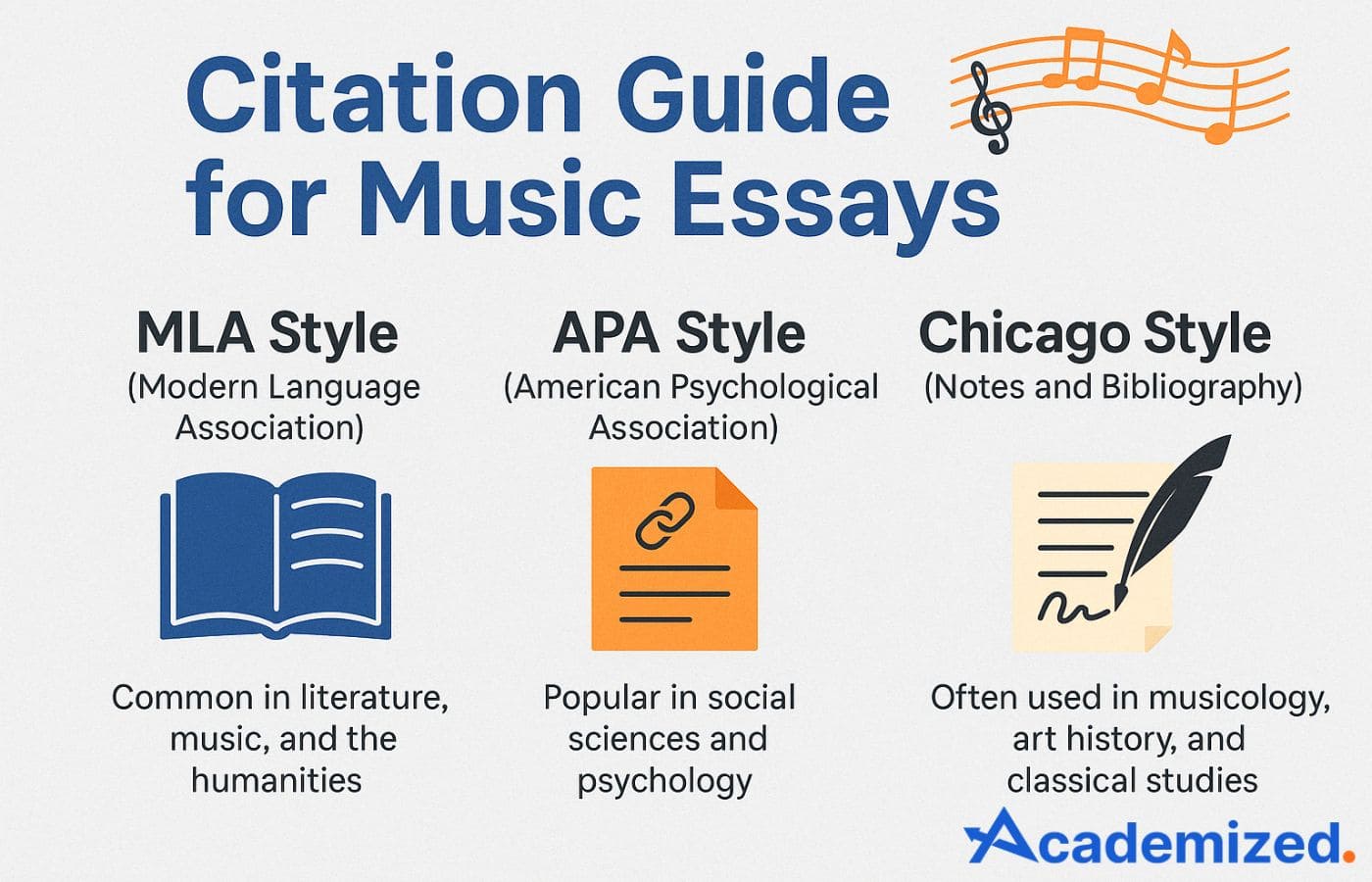- Blog
- How to Write an Outstanding Music Essay
How to Write an Outstanding Music Essay
 Mary Watson
Mary Watson

Writing about music can feel tricky, especially when trying to turn sounds and emotions into clear arguments. Many students wonder how to write a music paper that’s thoughtful and well-organized. You’ll need more than just a personal opinion or a love for the subject to do that. A good music essay should use evidence, context, and structure to explore the topic. Whether analyzing a piece, comparing styles, or discussing a composer’s influence, your writing must explain why the music matters and how it connects to larger ideas.
So, what’s the best way to approach it? Start with a clear thesis. Then, support your ideas with musical examples, historical context, or technical elements – depending on the focus of your prompt. Don’t forget to stay organized and stick closely to your topic. Music might be a creative subject, but your essay needs structure and clarity.
As a professional academic service, we’ve helped many education recipients express complex ideas about music with ease. This guide will walk you through the most effective ways to write a music essay, so you can confidently hit every note.
What Makes a Music Essay Different from the Rest?
A music essay is an academic piece that explores, explains, or analyzes music in detail. This might include writing about a song, a composer, a musical movement, or even the cultural impact of a particular genre. Unlike other essay types, this writing often blends technical analysis with emotional or historical insight. You might be asked to break down rhythm and harmony or explore the social meaning behind a composition. In every case, the goal is to connect sound with thought – to turn what we hear into what we understand.
Read also: A Guide to Writing All Types of Essays
Why Writing About Sound Requires a Special Approach
Music is one of the few subjects that can’t be seen or touched, which makes writing about it a bit unusual. While science or history essays often rely on complex data, this assignment challenges you to describe feelings, movements, and emotions through language. That’s why a high-quality music essay isn't just about structure – it’s also about listening closely and writing clearly. Combining your theoretical knowledge with creative interpretation will make this a unique academic task.
Music Essay Structure Guide from First Note to Final Draft
Step 1: Dive In and Listen
Before anything else, experience the music you're writing about. Play it more than once. Listen for instruments, tempo, patterns, and emotion. Try to identify what stands out and why. Jot down your first impressions and any details that repeat or shift throughout the piece. This isn’t just about enjoying the sound – it's about observing what the music is doing and how it affects the listener.
Step 2: Get to Know the Background
Once you've heard the piece, it’s time to look deeper. Research the composer, the historical period, and the style or genre of music. Find out where the work fits in the bigger picture. Whether you're writing about classical music or jazz, this step gives you the context to make your argument more meaningful. It also helps you avoid guessing and start writing with a real purpose.
Step 3: Break Down the Music
Now that you’ve listened and researched zoom in on the technical parts. This might include melody, harmony, dynamics, rhythm, or instrumentation. You might also discuss interpretation or technique if your essay focuses on a specific performance. Think of this as your evidence. Like quotes in a literature essay, your observations support your overall point.
Step 4: Pin Down Your Main Idea
After gathering enough insight, it’s time to pick your angle. Writing a thesis for a music essay keeps your writing focused and gives readers a clear sense of your purpose. Maybe you're arguing that a particular song reflects political change or that a symphony redefined a genre. Either way, make the claim specific, then support it with everything you've learned.
If you're struggling to develop a strong central argument, consider using our trusted thesis service for extra support. These services can help refine your main idea, ensure it aligns with your topic, and strengthen the foundation of your essay. Getting expert feedback early on can save time and improve the clarity of your entire structure.
Step 5: Organize Your Music Essay Body Paragraphs Before Writing
With a solid thesis in place, map out the flow of your essay. Start with an introduction that sets the stage, follow it with well-structured body paragraphs, and end with a meaningful conclusion. Make sure each section connects to your main idea. This outline doesn’t need to be perfect – but it keeps you on track and saves time later.
Step 6: Bring the Page to Life
When it’s time to start writing, aim for clarity first creativity second. Explain your points clearly, and avoid overcomplicating your language. Describe sounds that make sense to any reader, not just someone with musical training. At the same time, don't be afraid to show personality – let your voice reflect your understanding and passion for the subject.
Step 7: Tune Up Your Final Draft
Before you turn it in, read your essay from start to finish. Fix unclear ideas, tighten long sentences, and double-check your sources. Does each point support your thesis? Are your paragraphs in the correct order? These final touches may seem small, but they can make a big difference in how your essay reads. A polished piece always leaves a stronger impression.
Creative and Relevant Music Essay Ideas
Picking the right topic can make the writing process smoother and more interesting. A great music essay topic should be specific, relevant, and offer room for analysis – this is a key part of how to write a good music essay. Here are 10 fresh ideas that reflect current trends and academic interests:
- The Role of Protest Songs in Modern Social Movements
- How TikTok Is Shaping the Future of Pop Music
- The Influence of Classical Composition on Film Scores
- Exploring Identity Through Hip-Hop Lyrics
- How Technology Has Changed Music Production
- Women in Jazz: Overcoming Barriers in a Male-Dominated Genre
- Cultural Significance of K-Pop in Global Entertainment
- The Evolution of Music Streaming and Artist Visibility
- Analyzing the Impact of Auto-Tune on Vocal Performance
- Music Therapy: Healing Through Sound and Rhythm
Read also: A Complete Breakdown of the Poetry Analysis Essay
Music Essay Example for Better Writing
Title: Emotion in Sound – A Closer Look at Samuel Barber’s Adagio for Strings
Samuel Barber’s Adagio for Strings is one of American classical music's most emotionally stirring pieces. Composed in 1936, the work is widely known for its slow tempo, rich harmonies, and deep sense of sorrow. Often associated with mourning and national tragedy, the piece has been used in numerous public memorials and films, including Platoon and broadcasts following the deaths of U.S. presidents. Yet beyond its associations, the music holds expressive power that speaks to listeners across generations.
The piece begins with a single, sustained note that gradually rises into a melodic line passed between the strings. This slow build sets the emotional tone early, creating a sense of yearning. Barber carefully adds layers of harmony, each note pulling against the other with gentle dissonance. The pacing is deliberate, with long phrases that rise and fall like waves. Rather than rushing through ideas, Barber allows each moment to expand, letting the emotion breathe.
Adagio for Strings is especially impactful with its use of dynamics and silence. The piece slowly grows louder, reaching a dramatic climax near the end. The harmonies become more intense here, and the full-string section plays in unison, delivering overwhelming emotion. Immediately after this peak, the music drops into near silence. This sudden contrast feels like the moment after a deep cry – exhausted, empty, and still. The closing bars fade into a soft resolution, leaving the listener with quiet reflection rather than finality.
Barber’s choice to write for a string ensemble instead of a full orchestra contributes to the piece's intimacy. Nothing can distract from the emotional core without brass, percussion, or woodwinds. With their ability to mimic the human voice, strings directly connect sound and feeling. This connection is likely why the piece has remained a staple during national grief.
While Adagio for Strings is often linked to loss, it also invites hope. The piece does not resolve in despair; it lingers in reflection. Barber’s composition teaches us that music does not need words to convey powerful messages. He created a piece that continues to move audiences through structure, pacing, and tone, reminding us that music can be personal and universal.
In this way, Adagio for Strings is a beautiful piece of music and a timeless expression of human emotion.
Expert Tips on How to Write a Music Essay
Want your music essay to hit all the right notes? Here are some expert-backed tips to keep your writing clear, engaging, and effective:
- Stick to a focused idea: Instead of covering everything at once, choose one apparent angle or question to explore. This keeps your argument strong and your essay easier to follow.
- Write in plain, precise language: Music can be complex, but your writing doesn’t have to be. Break down tricky ideas into simple explanations your reader can easily understand.
- Use musical examples as evidence: Support each claim with specific details – such as a key change, a lyric, or a rhythm – that show what you're talking about. Real examples make your analysis more convincing.
- Explain the "why" behind the detail: Don’t stop at the description. One of the key tips for writing a music essay is to dig deeper – explore how the music supports your thesis or connects to broader themes like culture, identity, or history.
- Organize your essay with a clear structure: A strong intro, solid body paragraphs, and a meaningful conclusion help guide your reader through your ideas smoothly.
- Revise with fresh eyes: After writing, take a break before editing. Then, read your essay out loud to catch awkward phrasing, unclear sections, or repetition.
- Check formatting and citations: Follow the required citation style (APA, MLA, or Chicago) and ensure that all sources, recordings, texts, or articles, are appropriately credited.
- Stay true to your voice: Academic doesn’t mean boring. Let your personality come through where appropriate, especially when sharing interpretations or reactions.
If you find yourself stuck or short on time, using professional help can make a difference. Academized essay writing services offer reliable support for students who need structure, formatting, or editing guidance. Whether starting from scratch or just polishing your final draft, expert assistance can help you submit a stronger, clearer, and more confident essay.
Music Essay Mistakes to Avoid
Even strong writers can fall into traps when writing about music. A well-written essay not only shows musical knowledge but also demonstrates clarity, structure, and purpose. To help you stay on track, here are some common mistakes to watch out for:
- Summarizing music instead of analyzing it: Simply describing what you hear isn’t enough – your job is to explain what it means and how it supports your thesis.
- Forgetting to connect points to the thesis: Each paragraph should support your main argument. Straying too far off-topic weakens your overall message.
- Overloading the essay with technical terms: While using music terminology is essential, too much jargon can confuse readers. Keep your language clear and accessible.
- Ignoring historical or cultural context: Music doesn’t exist in a vacuum. Understanding a piece's time, place, or purpose adds depth to your analysis.
- Skip citations for key references: Always give credit where credit is due, whether it’s a scholarly quote or a detail about a recording.
- Repeating ideas without adding value: Avoid rephrasing the same thought across multiple paragraphs. Instead, expand your points with new evidence or angles.
- Neglecting the structure of your essay: A strong introduction, an organized body, and a thoughtful conclusion keep your essay clear and logical.
- Missing the emotional or thematic side of the music: Technical elements matter, but so does meaning. Don’t forget to explore the message or feeling the music conveys.
- Leaving little time for revision: First drafts are rarely final drafts. Give yourself enough time to edit, refine, and polish your work before submission.
Writing without a clear focus or argument: An unclear or scattered essay can confuse the reader. Stay focused on your thesis and make sure every point supports it.

Guide to Music Essay Format and Proper Citation
Correct formatting and citation are key to clarity and academic integrity in a music essay. A strong music essay format includes a clear introduction, well-organized body paragraphs, musical examples, and a thoughtful conclusion. Follow your instructor’s font, spacing, and structure guidelines – usually 12 pt Times New Roman, double-spaced, with 1-inch margins.
Depending on your field of study or your instructor’s preference, you’ll typically be asked to use one of the following citation styles: MLA, APA, or Chicago. Here’s a quick guide association)
MLA Style (Modern Language Association)
Common in literature, music, and the humanities. Focuses on the author and the title of the work.
Example: Mozart, Wolfgang Amadeus. The Magic Flute. 1791.
Use italics for musical titles and include performance details if relevant.
APA Style (American Psychological Association)
Popular in social sciences and psychology. Includes the date prominently.
Example: Beethoven, L. V. (1808). Symphony No. 5.
Use sentence cases for titles and provide links or retrieval information when referencing recordings or digital scores.
Chicago Style (Notes and Bibliography)
Often used in musicology, art history, and classical studies. Offers detailed formatting for performances, recordings, and scores.
Example: Johann Sebastian Bach, Brandenburg Concerto No. 3, 1721.
Footnotes are common in this style, especially for citing liner notes or program booklets.
Read also: Mastering Harvard Citation Style with Expert Tips
What I’ve Learned from Helping Students Write Music Essays
Writing about music is among the most rewarding academic work I’ve helped students with. There’s something uniquely powerful about turning notes and rhythms into words that explain, persuade, and inspire. Over time, I’ve noticed one consistent truth: the best music essays come from a place of genuine curiosity. It shows in your work if you're genuinely interested in the song, artist, or genre you're writing about. Applying the right music essay techniques in writing – from focused analysis to clear organization – helps transform that curiosity into a strong, thoughtful essay.
I always suggest reading your essay aloud once it's done. If it flows naturally, that’s a good sign. If something sounds off or hard to follow, take a moment to revise. Also, don’t worry if your first draft isn’t perfect – very few are. Writing is a process, not a one-shot deal. What matters is that each edit makes your ideas stronger and your message clearer. So stay patient, trust the process, and let your voice shine through. That’s how strong writing happens.
FAQ
What’s an Effective Approach to a Music Essay Introduction?
Start by briefly introducing the piece, artist, or theme, then lead into your main point. Example:
From protest songs to pop hits, music has always reflected the heartbeat of culture. This essay explores how….
What Makes a Good Opening Hook for a Music Essay?
A good hook grabs attention. Try a quote, stat, or question. Example:
Can a single chord change history? Some songs suggest it can.
What’s the Best Way to Format a Music Essay?
Follow the standard structure: introduction, body, and conclusion. Use paragraphs wisely and adhere to the required citation style (MLA, APA, or Chicago). Always check the assignment guidelines to be sure.
What’s a Good Music Essay Conclusion?
Summarize your key points and reword your thesis with fresh insight. Example:
As shown through rhythm, lyrics, and context, this song continues to echo social change even today.

Mary, our exceptional editor and online tutor, brings a wealth of knowledge to the table. With her extensive expertise in academic writing, she guides and mentors aspiring students, providing them with constructive feedback that propels their essays to the next level.


 Mary Watson
Mary Watson

